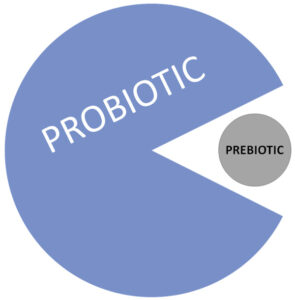In an earlier post, I discussed the importance of maintaining a healthy microbiome. This collective of microorganisms helps digest our foods, regulates metabolism and blood sugar, and participates actively in immune function. It also prevents bacterial invasion into the blood supply and thwarts infection from tainted foods. Most of these trillions of microorganisms live in our guts. We need to cultivate a diverse population of good microorganisms that minimize space available for bad ones.
Probiotics are live bacteria and yeasts that confer health benefits on the host when they are administered in adequate amounts and planted in an environment conducive to growth. Fermented foods such as yogurt, kefir, tempeh, miso, and sauerkraut are natural sources of probiotics. Fruits and vegetables are covered in lactic acid bacteria, some of which are the same strains found among our gut bacteria.1
 Prebiotics are compounds in foods that foster the growth or activity of beneficial microorganisms. They’re found in fruits and vegetables that have a high fiber content and/or starches that resist digestion. While we may not derive nutrients from these substances directly, our friendly microorganisms happily eat them up. Food sources include artichokes, asparagus, bananas, chicory root, garlic, leeks, legumes, onions, and whole grains. Just as we like variety in our diets, our microbiome responds favorably to different prebiotic food sources.
Prebiotics are compounds in foods that foster the growth or activity of beneficial microorganisms. They’re found in fruits and vegetables that have a high fiber content and/or starches that resist digestion. While we may not derive nutrients from these substances directly, our friendly microorganisms happily eat them up. Food sources include artichokes, asparagus, bananas, chicory root, garlic, leeks, legumes, onions, and whole grains. Just as we like variety in our diets, our microbiome responds favorably to different prebiotic food sources.
Our healthy gut biome dies off when we take broad-spectrum antibiotics. These lifesaving drugs do not have the sophistication to kill disease-causing bacteria while leaving the good stuff alone. The good guys also suffer in response to intestinal infection. Even stress has been associated with a substantive die-off of our healthy gut flora.2 In such cases, our once densely populated “gut garden” may become uncomfortably barren. Worse yet, unhealthy bacterial strains resistant to the effects of antibiotics, infection, or stress may attempt a hostile takeover of our guts.
Good nutrition can and should come to the rescue. Attentive consumption of a variety of fruits, vegetables, whole grains, and fermented foods nourishes our guts in good times and helps repopulate them after unanticipated reversals.
What about probiotic supplements?
According to nutritionfacts.org, the jury is still out on the safety and efficacy of these supplements. Most of the research to date has been sponsored by organizations with an economic interest in the findings, potentially leading to an overstatement of benefits and an underreporting of negative results.3 Moreover, even the most reputable products only supply a tiny fraction of microorganisms in relation to the trillions of bacteria and yeast needed to populate a healthy gut. Moreover, these prepackaged microorganisms may not survive their time on the store or household shelf and may not make it through the rigors of digestion.
Words to the wise: Focus on eating gut-friendly food. Avoid antibiotics unless medically necessary. Manage stress.
References: